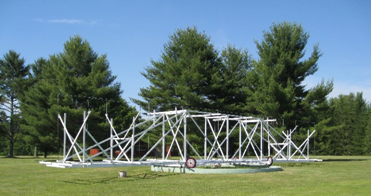- 1610: Galileo
- 1676: Ole Rømer
- 1687: Isaac Newton
- 1781: William Herschel
- 1838: Friedrich Bessel
- 1861: William and Margaret Huggins
- 1912: Henrietta Leavitt
- 1917 Einstein
- 1920: Harlow Shapley
- 1929 Edwin Hubble
- 1948: Ralph Alpher
- 1949: Fred Hoyle
- 1963: Maarten Schmidt
- 1964: Arno Penzias and Robert Wilson
- 1978: Vera Rubin and Kent Ford
- 1989: Margaret Geller and John Huchra
- 1992: John Mather and George Smoot
- 1995: Robert Williams
- 1998: Saul Perlmutter and Brian Schmidt
- 2010: Wendy Freedman
Karl Jansky’s Radio Antenna
 |
Full-size replica of the first radio telescope, built by Karl Jansky and now at the National Radio Astronomical Observatory (NRAO) in Green Bank, West Virginia |
As shown in the photo, Jansky designed his antenna to rotate in order to maximize the signal from different directions. He published his detection of radio waves from the galactic center in 1933, and the story was picked up by the New York Times. The article assured readers that the signals did not appear to come from extraterrestrial beings. Unfortunately, the importance of his discovery was not recognized until many years later, and Jansky was reassigned to other work. He died in 1950 at the age of 44.
Radio astronomy was given a boost from the development of radar during World War II, so that by the time Penzias and Wilson reached graduate school the science of radio astronomy had become established. Arno Penzias earned a Ph.D. in radio astronomy at Columbia, and Robert Wilson obtained his doctorate at Cal Tech where he took a graduate course in cosmology from Fred Hoyle. Penzias and Wilson met at Bell Labs, where they worked together on a giant horn antenna designed to detect microwaves.
The antenna had been built to communicate with the Echo satellite, which was a huge metallic balloon launched into orbit. An early experiment in satellite communications, Echo was intended to be a huge reflector in space that would bounce microwave signals back to Earth. Since Bell Labs was no longer working on that project the giant antenna was available for radio astronomy. Penzias and Wilson were given permission to use the horn antenna to conduct a survey of cosmic radio sources.
Before they began their research they wanted to reduce the extraneous noise as much as possible. For some unknown reason they had difficulty reducing a constant hiss that seemed to be picked up by the antenna. They checked and cleaned each component, strengthened connections, and even cleared out pigeons that were roosting inside and polished the entire surface of the antenna. After a full year’s effort they concluded that a microwave background was present they could not account for.
Near the end of 1964, Penzias attended an astronomy conference and learned that two astronomers at Princeton, Robert Dicke and James Peebles, predicted that the Big Bang would produce light that today would be detected as microwaves. This was the same prediction made by Alpher in 1948, but Peebles and Dicke were unaware of the earlier work. Penzias immediately called Dicke, and the two realized that the predicted signals had been found. They announced the discovery with two papers in the summer of 1965—one by Penzias and Wilson announcing the microwave signal, and one by Dicke and Peebles, interpreting its meaning in support of the Big Bang theory.
When Arno Penzias accepted the Nobel Prize for the discovery of what came to be known as the Cosmic Microwave Background (CMB) in 1978, he paid tribute to the earlier efforts by recounting the entire history, based largely on discussions with Ralph Alpher just a month before.